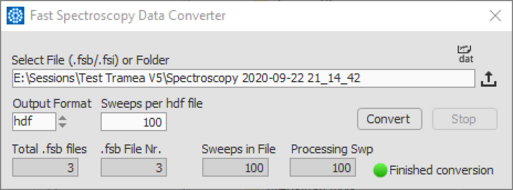Our newest, soon to be released measurement module offers measurement speeds to permit nanodevices to be tuned in real-time by acquiring data at video-rate speeds. And to simplify data processing, a conversion tool to hdf5 will also be available
One of Tramea’s main advantages is its capability to run measurements at very high speed. It does that with multiple high precision, low-noise voltage sources.
While measurement speed is often limited by the signal-to-noise ratio of the signal itself or by heavy filtering in the cryostat, there are measurement schemes which allow significantly higher bandwidths. These can be based, for example, on low-temperature amplifiers to boost the signal, or on reflectometry-type measurements which offer significantly larger bandwidth and signal-to-noise ratios.
Being able to visualize in real-time how a change in a measurement parameter (for example a gate voltage) affects the device being measured can significantly speed up the tuning procedure or deliver immediate spectroscopic information of the device. The new ultrafast measurement module can display 2D-data up to 20 frames per second, resulting in video-rate real-time data visualization, with simultaneous data acquisition at the same speed.
While this is not a new method, in the past such a measurement speed could only be achieved with arbitrary waveform generators and digitizers. Those instruments are surely fast enough, but their signal quality is relatively poor. Nanonis Tramea achieves video-rate measurements with the same 20-bit precision voltage outputs used to control static gate voltages thanks to its FPGA-based implementation.
And while fast data display can surely be useful, the module also allows data storage at the same speed. Up to 8 channels can be acquired simultaneously at 1 million samples per second, and up to 14 channels at 500 thousand samples per second or slower. To cope with the very large amount of data which can be generated at such measurement speeds, the measurements are streamed directly to disk bypassing the PC’s RAM, while a separate data stream with lower bandwidth is used for data display.
While speed is one of the advantages of the new module, another advantage is the capability to acquire datasets with very large resolution in a reasonable time. The module allows measurements with up to 1000000x1000000 points, offering unprecedented resolution and detail. Running at speeds up to the raw ADC data rate, the module follows a big-data approach where raw data are stored first and processed at a later stage.
Even though the module doesn’t offer all of the smart features for measurement optimization (intelligent adaptive oversampling, for example) of its slower companion, the 3D-sweeper, it still offers a double conditional direction-reverse function. This function stops the sweep of the main measurement axis if one and/then/or two conditions are met, thus offering a reduction in measurement time or additional safety for the sample as just two examples of what can be implemented.
The module offers both very fast measurements and very detailed data sets with an extremely large number of points. But how to handle all these data?
One of the most widespread data formats in the community is hdf5, which potentially would offer sufficiently high data write speeds for this application. Nanonis Tramea will offer full hdf5 support, starting with the new fast measurement module, and later on also for the 3D-sweep module.
Hdf5 offers very large write speeds, but is not suitable for high-speed concurrent write and read and does not work seamlessly with the measurement options of the Nanonis Tramea software. To avoid a CPU overload or issues with HDD data transfer speed, and thus data losses, and to make sure that data can be visualized while being stored, the Nanonis Tramea software does not save the data directly in a hdf5 file. It converts the raw data into a hdf5 file at the end of a measurement (or whenever the user manually starts the conversion) with an easy to use converter, ensuring that no data is being lost during the measurement and that the host PC doesn’t get unresponsive during the conversion.
These new features will be available for all Nanonis Tramea V5 and V5e users.



